Swiggy Case Study and Marketing Strategy: Revolutionizing Food Delivery in India

A decade ago, few could have predicted the meteoric rise of online food delivery services in India. Among the frontrunners is Swiggy, a platform that has redefined convenience in food ordering and delivery. Launched in 2014, Swiggy has successfully navigated fierce competition, especially from Zomato, to establish itself as the “largest online food ordering and delivery platform” in the country.
This article explores Swiggy’s journey, from its inception to its innovative marketing strategies, providing valuable insights for budding entrepreneurs and startups.
Who Founded Swiggy?
Swiggy was the brainchild of three visionaries: Sriharsha Majety, Nandan Reddy, and Rahul Jaimini.
- Sriharsha Majety: An alumnus of BITS Pilani and IIM, Majety co-founded Bundl Technologies Pvt Ltd before pivoting to Swiggy.
- Nandan Reddy: With an M.Sc. from BITS Pilani, Reddy gained entrepreneurial experience as a founding partner of Zurna, a Hyderabad-based restaurant, before teaming up with Majety.
- Rahul Jaimini: An IIT Kharagpur graduate, Jaimini brought technical expertise to Swiggy, designing its software and mobile applications after working with firms like Philips.
The Story Behind Swiggy
In 2013, Majety and Reddy ventured into logistics with Bundl Technologies, which, unfortunately, did not succeed. However, the failure laid the groundwork for their pivot into the food delivery industry. In 2014, Swiggy was launched, with Jaimini spearheading the technological aspects. Initially operating in a small region with six delivery personnel and 20+ restaurant partners, Swiggy soon found itself competing with Foodpanda and Ola Café. Over time, it steadily carved a niche, blending innovation and user-centric design.
Swiggy’s Funding Journey
Swiggy has achieved exponential growth, thanks to significant financial backing from global investors. Here’s an overview of its major funding milestones:
- May 2017: $80M in Series E funding
- February 2018: $100M in Series F led by Prosus Ventures
- June 2018: $210M in Series G from Prosus Ventures and DST Global
- December 2018: $1B in Series H led by Prosus Ventures
- April 2021: $800M in Series J led by Falcon Edge Capital and Prosus Ventures
- July 2021: $1.3B in funding from SoftBank Vision Fund 2, Prosus Ventures, and Accel Partners
To date, Swiggy has raised over $3.7 billion across 15+ funding rounds.
Swiggy’s Revenue Model
Swiggy employs a multi-faceted revenue model, including:
- Commissions: Restaurants pay a commission of 20-25% per order received through Swiggy.
- Delivery Fees: Customers pay delivery charges, which vary by distance and surge during peak demand or adverse weather.
- Paid Promotions: Restaurants pay for visibility through sponsored listings and advertisements within the app.
- Instamart: Launched in 2020, Swiggy’s quick grocery delivery service caters to urban consumers, completing over a million weekly orders.
- Swiggy One: A premium subscription program offering benefits like free deliveries and exclusive discounts, boosting customer retention.
Swiggy’s Marketing Strategies
Swiggy excels in leveraging digital marketing to engage its audience. Here’s how:
- Social Media: Swiggy’s witty, trend-inspired posts and hashtags like #EarnYourCheatMeal and #NoOrderTooSmall captivate users on platforms like Instagram, Twitter, and Facebook.
- Email Campaigns: Eye-catching emails with vibrant graphics and timely deals, especially during events like IPL and World Cup, keep customers hooked.
- PPC Advertising: Swiggy invests in Google ads and social media promotions, ensuring visibility for its partner restaurants and popular dishes.
Acquisitions and Expansions
Swiggy has expanded its reach through strategic acquisitions:
- 48East (2017): A Bengaluru-based Asian food startup.
- Scootsy Logistics: Acquired in 2017, later discontinued.
- SuprDaily: A milk delivery startup acquired in an all-cash deal.
Awards and Recognition
- Joined the Unicorn club in just four years with a valuation exceeding $1 billion.
- Received the Outlook Social Media Award in 2016.
- Honored as the “Startup of the Year” by Economic Times in 2017.
Competition in the Market
Swiggy’s primary competitor, Zomato, remains a formidable rival. While Swiggy records a daily order volume of 1.5 million compared to Zomato’s 1.2 million, the latter’s acquisition of UberEats and aggressive marketing strategies have intensified competition. With Zomato operating in 550+ cities, Swiggy must continue innovating to maintain its edge.
Conclusion
Swiggy’s journey reflects the power of innovation, adaptability, and strategic execution. By diversifying its offerings with services like Instamart and Swiggy One, the company has set a benchmark in customer-centricity. However, it faces stiff competition from Zomato, which continues to expand aggressively.
The story of Swiggy offers invaluable lessons for startups, demonstrating the importance of resilience, funding, and marketing in building a successful business.



